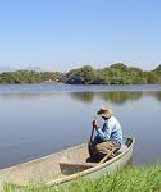
Baltasar Hernández:
"love, respect and
care for the planet."

Climate change is no longer just an omen, an exaggeration or a threat, but has become a reality. Meanwhile, solar energy has become a clean alternative that the community of San Blas has recently begun to exploit with help from the Secretary of the Navy (Semar).
According to sailor Baltasar Hernández, this is a project that has been in the planning stages for years. However, it lacked authorization from Semar in Mexico City and because of the cost, it was only possible to complete two months ago.
With 15 years of experience in the Navy and a deep love for his work and community of San Blas, Hernandez explained that with photovoltaic cells (solar panels) placed in the maritime zone, they are able to take advantage of the sun’s energy to generate and supply street lighting.
Photovoltaic cells capture radiation emitted by the sun and charge batteries which then provide energy for street lights.
At the same time that they provide the community with lighting, solar panels are benefitting the San Blas marina economically.
Before adding these solar panels, the monthly bill paid to the Federal Commission of Electricity (the electric company) was very high. According to Hernández, even though the initial investment for the panels was an obstacle, there is no longer a regular bill.

Solar Energy
Clean Alternative for San Blas
The residents of San Blas have begun to question how shrimp farms have changed the face of the coast in just one generation, affecting access to food resources and the local subsistence economy.
“Why can’t we catch shrimp anymore?” asks Mario Cutberto Rivera Aldaco. “Because they have taken over all of the shrimp’s natural habitats,” he answers.
Thirty year-old Rivera Aldaco is a native of the port of San Blas. Like many people of his generation, he remembers the marshes and lagoons where his father once took him to teach him how to catch shrimp. “Where are the coastal shrimp that used to be the principal source of food for San Blas families?” he asks.
He admits to feeling frustrated, since he’s talking about 1990, the year that they started building the now well-known shrimp farms. While he isn‘t against shrimp farming in general, he does miss being able to catch shrimp in the old marshes as he once did.
His objection is that the natural lagoons have been transformed into shrimp farms, which are surrounded by signs warning against trespassing and identifying the area as private property.
“Why can’t we catch shrimp anymore? Because they have taken over and blocked access to all of the shrimps‘ natural refuges” he answers his own question.
Shrimp normally enter estuary zones to seek refuge while maturing. Respecting this natural cycle, Rivera and others caught shrimp during open season, which lasted from early October until the end of November or even early December.

Now, besides catching shrimp and not allowing them to leave the estuary, shrimp farmers are also contaminating the environment. This is changing the normal lifecycle of the shrimp.
“If this isn’t stopped, it could affect not only the very existence of shrimp, but also the species that live off of them,” warns Rivera. “When the food chain is altered, the entire ecosystem is also altered and the world will cease to be as we have known it” he says.
That is why he says “we need to find a solution before it is too late.”